Notion Excavation House
archeological and cultural facilities design

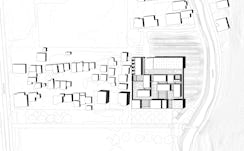
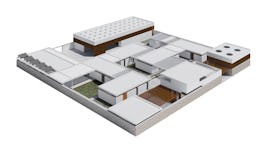
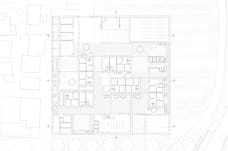


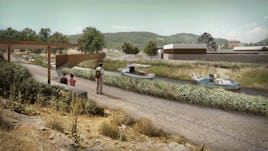

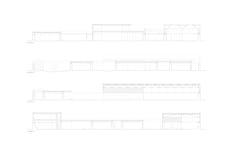
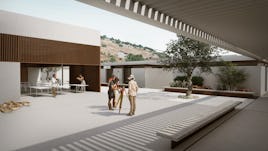
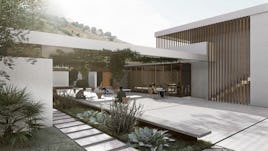
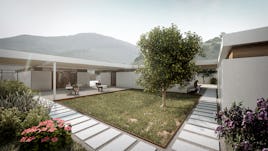
The Archaeological research work on the Notion site has to date been limited to site survey and geophysical prospection activities, using non-invasive techniques. The team however anticipates being approved by the Turkish Ministry of Culture to undertake excavation on the site. At this time, the archaeologists will be required to construct a “depot” building; a secure structure for storing and conserving archaeological finds from the site. They will also require residential quarters for the team for the duration of the field season, as well as associated work, dining, and social spaces. This entire complex is referred to as the excavation house.
As part of our involvement with the project, we have developed the schematic design for the future excavation house. Archaeological research activities are often criticized for their lack of integration with local communities and their lack of engagement with local cultures. The vision for the Notion Excavation House is that it will be situated within Ahmetbeyli beach town, where the archaeologists will be able to participate in the daily life and businesses of the town. Conversely, the archaeological work will be made more accessible and visible to local citizens and visitors. Another aspiration is that the overall development would contribute to improving the urban design and public spaces of the town.
The project is conceived of as an urban assemblage: a field condition of loosely organized individual pavilions with roofed and open air outdoor rooms, where team members can find a variety of spaces to work, socialize, or spend quiet time after their intensive work on site. The mat building approach allows for flexible reconfiguration of program elements and the ability to construct the complex over time. Buildings can more easily self-shade, and the outdoor work spaces will be shaded by the canopies that intermittently infill the column and frame structure.
The excavation house complex is located on a currently open field property adjacent to the Hales River, and overlooking a large public park in front of the beach. This location enables it to become a gateway to the site from the town, formalizing the north edge of the park with a new landscaped forecourt. The program is broken into smaller individual buildings in order to be sympathetic to the small-scaled structures of the adjacent town. Additionally, as the entire area of the beach town is classified as a “3rd Degree Archaeological Zone” all structures need to have shallow foundations and be potentially removable. The landscape around the complex will form a constructed wetland that will help process urban stormwaters and contribute to the rehabiliatation efforts of the Hales River . Within the complex itself, several of the courtyards will be planted to serve as additional stormwater catchment areas.
The program of the excavation house was developed in close discussion with the archaeological team over the several years that we have been working on the site. Working in the field with the team also enabled us to be embedded with the daily life of archaeologists, providing insights into their patterns, practices, and needs that the design can provide for. In our meetings with members of the local community, we also found that most knew very little about the history of the site and the region, but were eager to know more, as well as to know more about the activities of the archaeologists.
The excavation house complex is organized with public buildings on the south side adjacent to the park, the research and depot buildings on the north end of the complex, and the residential buildings located between the two, where it is most quiet and private. At the corner of the park is a public gallery building. It will be used to as a display space to showcase the ongoing findings and research of the archaeologists, and will also be used as a space for public meetings and educational group visits. Although the complex is walled to provide the required security for the archaeological finds and the equipment used by the team, the public gallery and main entry gate is porous and inviting to members of the community.
From the exterior of the complex, the massing reads as a series of striated bands. The complex is surrounded by a perimeter wall of dry laid local stone, a common construction technique in the region. The buildings are constructed of simple concrete and masonry finished in plaster. All of the buildings have clerestory operable panels alternately glazing or opaque and providing natural ventilation. Facing to the exterior, these operable units are covered in a grill of self-weathering steel. Entry canopies and security grilles at the gallery and depot are made of self-weathering steel. The gallery and depot are expressed as taller volumes rising above the perimeter wall with a prescast facia appearing to float above the wall and steel grilles. While most of the pavilions and buildings in the complex are finished in a modest uniform treatment, soffits at the gallery, depot and dining pavilion are given unique expression. A wood clad soffit over the dining space bulges downwards over the dining area. The gallery is toplit by four skylights with carved volumes finished in plaster punctuating the structural frame. In the depot, an aluminum screen is draped below the bottom chord of steel truss structures diffusing light from an array of skylights above.
The excavation house is also conceived in its longer temporalities. Once the archaeological research on the Notions site is complete, the complex is envisioned to be turned into a research center and open air museum, and the gallery to become a small visitor and learning center for the site. In this phase, the volumes receiving a special soffit treatment will form the primary public program spaces of the complex.
| Typology | Cultural Facilities Design |
| 2015-present |
Team
| RVTR | Kathy Velikov, Geoffrey Thün, Dicle Taskin, Dan Tish, Salvador Lindquist, Karen Toomasian, Jen Ng |
| Archeological Team Collaborators | Christopher Ratté, Felipe Rojas, Angela Committo |